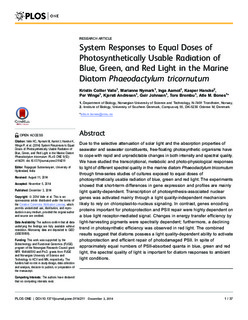| dc.contributor.author | Valle, Kristin Collier | |
| dc.contributor.author | Nymark, Marianne | |
| dc.contributor.author | Aamot, Inga | |
| dc.contributor.author | Hancke, Kasper | |
| dc.contributor.author | Winge, Per | |
| dc.contributor.author | Andresen, Kjersti | |
| dc.contributor.author | Johnsen, Geir | |
| dc.contributor.author | Brembu, Tore | |
| dc.contributor.author | Bones, Atle M. | |
| dc.date.accessioned | 2015-11-24T09:28:28Z | |
| dc.date.accessioned | 2015-12-09T12:05:44Z | |
| dc.date.available | 2015-11-24T09:28:28Z | |
| dc.date.available | 2015-12-09T12:05:44Z | |
| dc.date.issued | 2014 | |
| dc.identifier.citation | PLoS ONE 2014, 9(12) | nb_NO |
| dc.identifier.issn | 1932-6203 | |
| dc.identifier.uri | http://hdl.handle.net/11250/2367363 | |
| dc.description.abstract | Due to the selective attenuation of solar light and the absorption properties of seawater and seawater constituents, free-floating photosynthetic organisms have to cope with rapid and unpredictable changes in both intensity and spectral quality. We have studied the transcriptional, metabolic and photo-physiological responses to light of different spectral quality in the marine diatom Phaeodactylum tricornutum through time-series studies of cultures exposed to equal doses of photosynthetically usable radiation of blue, green and red light. The experiments showed that short-term differences in gene expression and profiles are mainly light quality-dependent. Transcription of photosynthesis-associated nuclear genes was activated mainly through a light quality-independent mechanism likely to rely on chloroplast-to-nucleus signaling. In contrast, genes encoding proteins important for photoprotection and PSII repair were highly dependent on a blue light receptor-mediated signal. Changes in energy transfer efficiency by light-harvesting pigments were spectrally dependent; furthermore, a declining trend in photosynthetic efficiency was observed in red light. The combined results suggest that diatoms possess a light quality-dependent ability to activate photoprotection and efficient repair of photodamaged PSII. In spite of approximately equal numbers of PSII-absorbed quanta in blue, green and red light, the spectral quality of light is important for diatom responses to ambient light conditions. | nb_NO |
| dc.language.iso | eng | nb_NO |
| dc.publisher | Public Library of Science | nb_NO |
| dc.relation.uri | http://www.plosone.org/article/metrics/info%3Adoi%2F10.1371%2Fjournal.pone.0114211 | |
| dc.title | System responses to equal doses of photosynthetically usable radiation of blue, green, and red light in the marine diatom Phaeodactylum tricornutum | nb_NO |
| dc.type | Journal article | nb_NO |
| dc.type | Peer reviewed | en_GB |
| dc.date.updated | 2015-11-24T09:28:28Z | |
| dc.source.volume | 9 | nb_NO |
| dc.source.journal | PLoS ONE | nb_NO |
| dc.source.issue | 12 | nb_NO |
| dc.identifier.doi | 10.1371/journal.pone.0114211 | |
| dc.identifier.cristin | 1170867 | |
| dc.description.localcode | © 2014 Valle et al. This is an open-access article distributed under the terms of the Creative Commons Attribution License, which permits unrestricted use, distribution, and reproduction in any medium, provided the original author and source are credited. | nb_NO |
